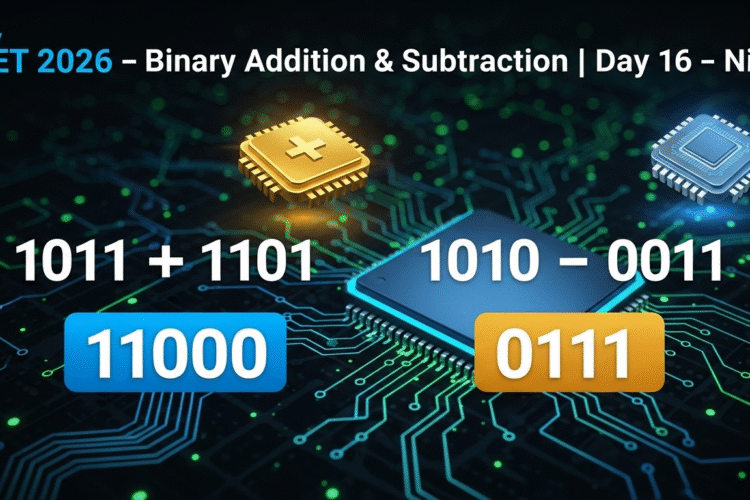
In ECET 2026, the topic Transmission Media is part of Computer Networks and is one of the most frequently tested areas. Whether it’s wired or wireless, understanding how data travels through different media is essential for solving network-based questions quickly. This topic is not only theoretical and scoring, but also helps in real-world networking knowledge.
📘 Concept Notes – Transmission Media Overview
🌐 Definition:
Transmission media refers to the physical path or channel through which data is transmitted from one device to another in a network.
🖧 Types of Transmission Media:
1️⃣ Wired (Guided) Media
Data signals are transmitted through a physical medium.
- Twisted Pair Cable:
- Consists of pairs of insulated copper wires twisted together.
- Types: UTP (Unshielded Twisted Pair), STP (Shielded Twisted Pair).
- Used in LANs.
- Advantages: Cheap, easy to install.
- Limitation: Short distance, susceptible to interference.
- Coaxial Cable:
- Central copper conductor with insulation and shielding.
- Better noise resistance than twisted pair.
- Used in cable TV, broadband.
- Optical Fiber:
- Uses light signals instead of electrical signals.
- High speed, long-distance, immune to EMI.
- Used in backbone networks and ISPs.
2️⃣ Wireless (Unguided) Media
Signals are transmitted without a physical medium, using electromagnetic waves.
- Radio Waves:
- Range: Few meters to kilometers.
- Used in FM radio, Bluetooth, Wi-Fi.
- Microwaves:
- High-frequency waves, point-to-point communication.
- Used in satellite links, cellular networks.
- Infrared:
- Short-range communication.
- Used in TV remotes, short-distance device communication.
- Satellite Communication:
- Long-distance coverage, uses geostationary satellites.
📌 Key Differences Between Wired & Wireless:
| Feature | Wired Media | Wireless Media |
|---|---|---|
| Medium | Physical cables | Electromagnetic waves |
| Speed | Generally higher (fiber) | Moderate to high |
| Security | More secure | Less secure (needs encryption) |
| Cost | Installation cost high (fiber) | Lower for small networks |
| Range | Limited by cable length | Wide coverage possible |
🔟 10 Most Expected MCQs – ECET 2026 [Transmission Media]
Q1. Which cable is most commonly used in LANs?
A) Coaxial
B) Twisted Pair
C) Optical Fiber
D) HDMI
Q2. Optical fiber transmits data using:
A) Electric signals
B) Magnetic waves
C) Light signals
D) Sound waves
Q3. Which medium has the highest bandwidth?
A) Twisted Pair
B) Coaxial
C) Optical Fiber
D) Radio Waves
Q4. Which wireless medium is used for satellite communication?
A) Infrared
B) Microwave
C) Radio
D) Optical
Q5. Which is the cheapest wired medium?
A) Optical Fiber
B) Twisted Pair
C) Coaxial Cable
D) None
Q6. In which medium is data most immune to electromagnetic interference?
A) Coaxial
B) Twisted Pair
C) Optical Fiber
D) Microwave
Q7. Which transmission medium is used in TV remotes?
A) Microwave
B) Infrared
C) Radio Waves
D) Coaxial
Q8. Which medium has the shortest range?
A) Optical Fiber
B) Infrared
C) Radio Waves
D) Microwave
Q9. UTP stands for:
A) Ultra Transmission Protocol
B) Unshielded Twisted Pair
C) Universal Transfer Port
D) Unified Twisted Protocol
Q10. Which wireless medium requires a direct line of sight between transmitter and receiver?
A) Microwave
B) Radio Waves
C) Infrared
D) Both A and C
✅ Answer Key Table
| Q.No | Answer |
|---|---|
| Q1 | B |
| Q2 | C |
| Q3 | C |
| Q4 | B |
| Q5 | B |
| Q6 | C |
| Q7 | B |
| Q8 | B |
| Q9 | B |
| Q10 | D |
🧠 Explanations of All Answers
- Q1 → B: Twisted pair cables are widely used in LAN connections.
- Q2 → C: Optical fibers carry light pulses to transmit data.
- Q3 → C: Optical fiber offers the highest bandwidth and speed.
- Q4 → B: Microwaves are used in satellite communication.
- Q5 → B: UTP cables are the most affordable wired option.
- Q6 → C: Optical fiber is immune to electromagnetic interference.
- Q7 → B: Infrared signals are used in remote controls.
- Q8 → B: Infrared works only over very short distances.
- Q9 → B: UTP = Unshielded Twisted Pair.
- Q10 → D: Both microwave and infrared need direct line-of-sight.
🎯 Why This Practice Matters for ECET 2026
Transmission media questions are direct and easy in ECET. By mastering the differences, uses, and examples of wired and wireless media, you can answer 1–2 marks worth of questions instantly. This also builds a strong base for network-related competitive exams and real-world networking projects.
📲 Join Our ECET Prep Community on Telegram
Get daily MCQs, PDF notes, and live discussion sessions for ECET 2026 prep.
👉 @LearnNewThingsHub
![]()

